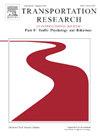Examination of naturalistic driving behavior and risk events across concussion recovery
IF 3.5
2区 工程技术
Q1 PSYCHOLOGY, APPLIED
Transportation Research Part F-Traffic Psychology and Behaviour
Pub Date : 2025-03-12
DOI:10.1016/j.trf.2025.02.017
引用次数: 0
Abstract
Driving simulator studies show that individuals with acute concussion present notable alterations in driving performance and perform better as recovery progresses. Although driving simulators create a safe environment and are capable of immersing individuals in realistic driving scenarios, they fail to capture daily naturalistic driving behavior throughout concussion recovery. Therefore, the purpose of the study was to describe naturalistic driving behaviors and risk events in individuals with concussion, relative to the control group. Twelve individuals with concussion and 17 non-concussed controls installed a GPS sensor in their personal vehicle for a 14-day period. We compared driving behavior (total distance driven, total duration driven, average speed, and number of trips taken per day) and risk events (number of hard brakings and sudden accelerations) captured between groups. Hedge’s g and linear mixed regression models were used to compare driving behavior and risk events. Individuals with concussion appeared to drive less and slower prior to day 3 post-concussion but displayed similar driving behavior after day 3 of post-concussion, relative to the control group. Additionally, we observed a pattern that the concussion group drove slower than the control group across concussion recovery. Our study provides preliminary evidence that suggests a need for a return to driving strategy to ensure the safety of individuals with concussion.
脑震荡恢复过程中自然驾驶行为和危险事件的研究
驾驶模拟器研究表明,急性脑震荡患者在驾驶表现上有显著的变化,并且随着康复的进展表现更好。尽管驾驶模拟器创造了一个安全的环境,能够让人沉浸在现实的驾驶场景中,但它们无法捕捉到脑震荡恢复过程中日常的自然驾驶行为。因此,本研究的目的是描述脑震荡个体的自然驾驶行为和风险事件,相对于对照组。12名脑震荡患者和17名非脑震荡患者在他们的私家车中安装了GPS传感器,为期14天。我们比较了各组之间的驾驶行为(总行驶距离、总行驶时间、平均速度和每天行驶次数)和风险事件(硬刹车和突然加速次数)。使用Hedge’s g和线性混合回归模型比较驾驶行为和风险事件。与对照组相比,脑震荡患者在脑震荡后第3天前的驾驶次数较少,速度较慢,但在脑震荡后第3天表现出相似的驾驶行为。此外,我们观察到脑震荡组在脑震荡恢复期间开车速度比对照组慢。我们的研究提供了初步的证据,表明有必要恢复驾驶策略,以确保脑震荡患者的安全。
本文章由计算机程序翻译,如有差异,请以英文原文为准。
求助全文
约1分钟内获得全文
求助全文
来源期刊
CiteScore
7.60
自引率
14.60%
发文量
239
审稿时长
71 days
期刊介绍:
Transportation Research Part F: Traffic Psychology and Behaviour focuses on the behavioural and psychological aspects of traffic and transport. The aim of the journal is to enhance theory development, improve the quality of empirical studies and to stimulate the application of research findings in practice. TRF provides a focus and a means of communication for the considerable amount of research activities that are now being carried out in this field. The journal provides a forum for transportation researchers, psychologists, ergonomists, engineers and policy-makers with an interest in traffic and transport psychology.

 求助内容:
求助内容: 应助结果提醒方式:
应助结果提醒方式:


